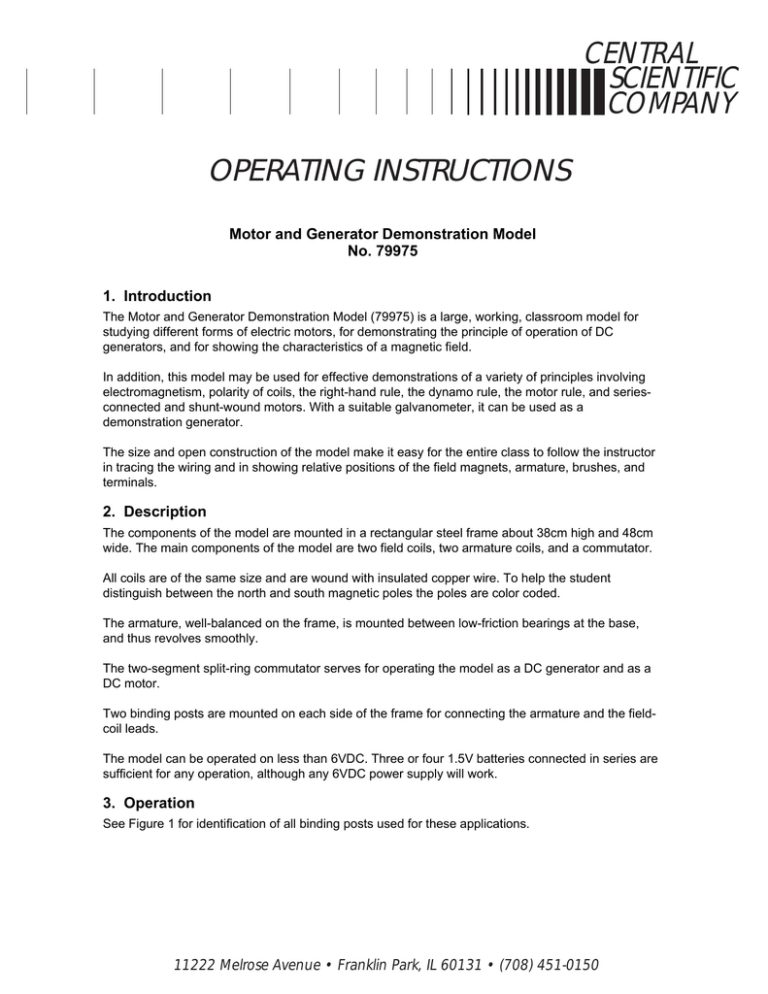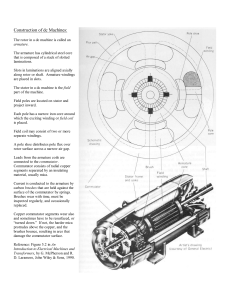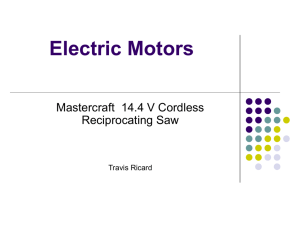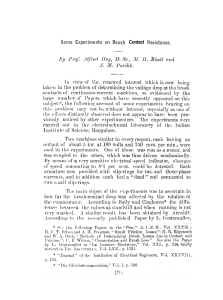
CENTRAL
SCIENTIFIC
COMPANY
OPERATING INSTRUCTIONS
Motor and Generator Demonstration Model
No. 79975
1. Introduction
The Motor and Generator Demonstration Model (79975) is a large, working, classroom model for
studying different forms of electric motors, for demonstrating the principle of operation of DC
generators, and for showing the characteristics of a magnetic field.
In addition, this model may be used for effective demonstrations of a variety of principles involving
electromagnetism, polarity of coils, the right-hand rule, the dynamo rule, the motor rule, and seriesconnected and shunt-wound motors. With a suitable galvanometer, it can be used as a
demonstration generator.
The size and open construction of the model make it easy for the entire class to follow the instructor
in tracing the wiring and in showing relative positions of the field magnets, armature, brushes, and
terminals.
2. Description
The components of the model are mounted in a rectangular steel frame about 38cm high and 48cm
wide. The main components of the model are two field coils, two armature coils, and a commutator.
All coils are of the same size and are wound with insulated copper wire. To help the student
distinguish between the north and south magnetic poles the poles are color coded.
The armature, well-balanced on the frame, is mounted between low-friction bearings at the base,
and thus revolves smoothly.
The two-segment split-ring commutator serves for operating the model as a DC generator and as a
DC motor.
Two binding posts are mounted on each side of the frame for connecting the armature and the fieldcoil leads.
The model can be operated on less than 6VDC. Three or four 1.5V batteries connected in series are
sufficient for any operation, although any 6VDC power supply will work.
3. Operation
See Figure 1 for identification of all binding posts used for these applications.
11222 Melrose Avenue • Franklin Park, IL 60131 • (708) 451-0150
79975 Motor and Generator Demonstration Model
Page 2
Figure 1
This figure is drawn from the viewpoint of the operator when facing the motor on the same side as
the binding posts. A and B represent the two upper binding posts, C and h the two lower binding
posts.
3.1 Series Motor
Secure the leads from the armature to binding posts A and B. Connect three or four 1.5VDC dry
cells in series to the binding posts marked C and D. Note the direction of motor rotation. Reverse the
connections to the binding posts. The motor still rotates in the same direction. Why?
3.2 Shunt-Wound Motor
Secure the leads from the armature to binding posts C and D. Connect binding posts A and B
together. Connect three or four 1.5VDC dry cells in series to binding posts C and D. Connections
from the battery may be reversed without affecting the direction of rotation.
3.3 Generator
Disconnect the armature leads from the binding posts. Connect binding posts A and B together.
Make connections to C and D from three or four 1.5VDC dry cells wired in series.
Connect the leads from the armature to either a 5V voltmeter or to a 1A ammeter. For classroom
demonstrations, a lecture meter (such as our AC-DC Multirange Projection Meter, 82551) can be
used.
Rotate the armature with the hand and note deflection of the meter. The deflection should vary with
the speed of rotation.
Reverse the direction of rotation and observe the deflection.
4. Suggestions for Study
Note that the armature consists of two coils wound so that the current in each is flowing in the same
direction about the metal core. This arrangement makes one end of the armature a north pole when
the other end is a south pole. The magnetic field is produced by two field coils wound so as to create
a 2-pole field magnet. Examine the commutator and count the number of segments. The brushes are
simple metal strips. Brushes of carbon are generally used on motors and generators.
Study the polarity of the field coils with a compass. The polarity of the field coils does not change
when the motor is running. Note the polarity of each end of the armature as it approaches a field coil
and as it moves away from the coil. The polarity of either end of the armature should be opposite to
that of the field coil on approaching and the same as that of the field coil on moving away. Recall that
unlike poles attract and like poles repel. The armature will rotate in such a direction that it meets the
above conditions.
Shift the position of the brushes and note the effect on the action of the motor. The brushes should
move from one segment of the commutator to the next while the armature is in line with the pole
pieces.
CENTRAL SCIENTIFIC COMPANY
11222 Melrose Avenue • Franklin Park, IL 60131 • (708) 451-0150
79975 Motor and Generator Demonstration Model
Page 3
5. Maintenance
The Motor and Generator Demonstration Model needs no special maintenance. If you should
experience any difficulty with this apparatus, please contact Central Scientific Company, giving
details of the problem. To ensure better service, please do not return any item to Central Scientific
Company until we have sent you authorization.
6. Copyright Notice
The Motor and Generator Demonstration Model operating instructions are copyrighted and all rights
reserved. Permission is granted to all non-profit educational institutions to make as many copies of
these instructions as they like as long as it is for the sole purpose of teaching students.
Revised 3/92
© 1992 Central Scientific Company
CENTRAL SCIENTIFIC COMPANY
11222 Melrose Avenue • Franklin Park, IL 60131 • (708) 451-0150





